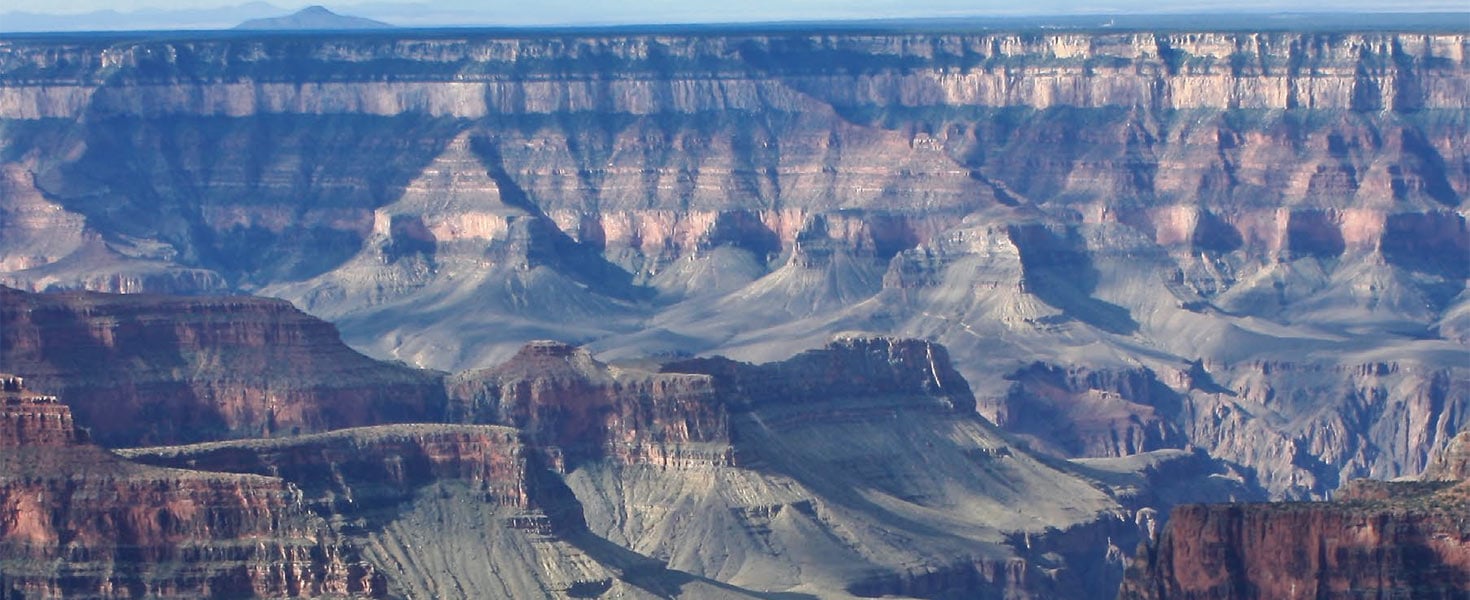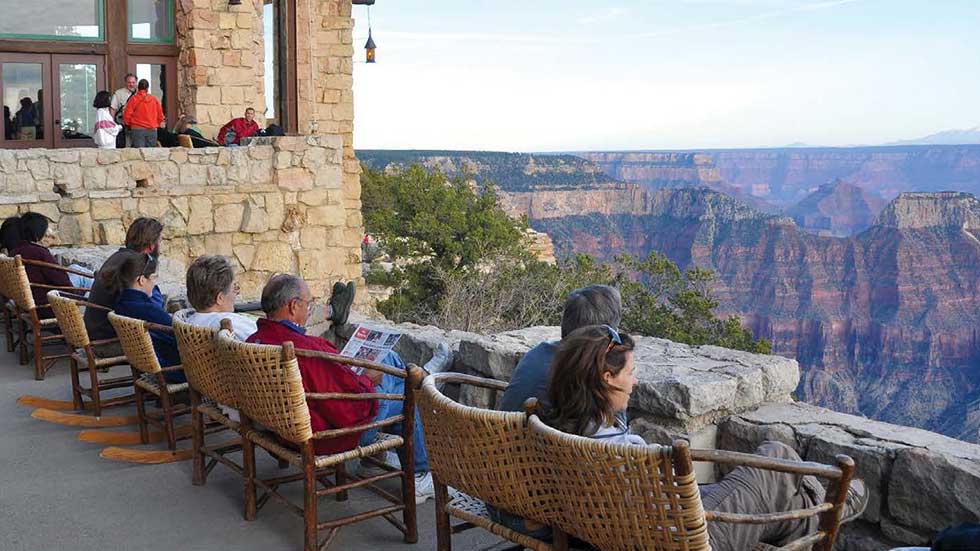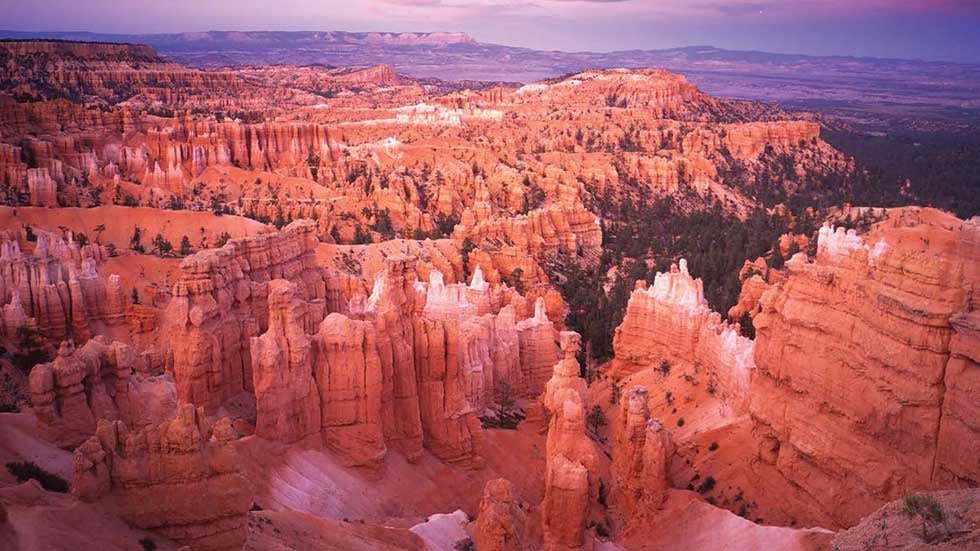Make family memories with a national parks vacation
For family togetherness, go west


“Whoa!” said my daughter Allie, as she peered over the massive gorge that is the Grand Canyon. “Whoa” may be the most common phrase we uttered during that family vacation, when my husband, two daughters and I traveled to three of America’s legendary national parks.
We began the journey by flying to Las Vegas joined by our friends, Amy and Mark Peterson, and their four children. The kids in our group were ages 8 to 17, and trying to decide where to go on our joint family vacation had not been easy. We parents were thrilled when they all seemed excited about a national parks adventure. After arriving in Nevada, we rented a van and drove across the Hualapai Indian Reservation on our way to the North Rim entrance of Grand Canyon National Park. En route, we stopped at a roadside stand to try corn cakes and beef jerky.
THE COLORADO PLATEAU’S GRANDEST CANYON
At the North Rim’s Grand Canyon Lodge, a stone and timber building hovering over Bright Angel Point, we caught our first glimpse of the cavernous ravine. “Whoa,” I thought, as I stared into the chasm with soul-gripping awe. You’ve seen pictures, but they can never prepare you for the spectacle of a 5,780-foot-deep gap in multihued layers of rock, a geological wonder with its oldest rocks dating back 1.75 million years. The Colorado River that flows through the Grand Canyon took its present course about 6 million years ago and likely flows through canyons that formed as long as 70 million years ago.
Our families were assigned to the lodge’s rustic cabins, some with views overlooking the Grand Canyon. We ate dinner in the lodge’s massive dining room, where they easily accommodated our group. With floor-toceiling windows surrounding us, it was hard to stop staring at the templelike mountains and plunging cliffs.

COURTESY OF NATIONAL PARK SERVICE
On our first morning of exploring the canyon, as mist lingered between the pine trees, Luke and Danielle, the youngest of our bunch, kept scaring us by leaning too far over the rim. They’re both daredevils, so we decided the safest way to explore was on the back of a sure-footed mule. We signed up with Canyon Trail Rides, a concessionaire of the National Park Service, and then soaked up the views while the gentle mules skillfully navigated the Ken Patrick Trail to the Uncle Jim Trail. As we meandered along, our wrangler shared stories about the history and geology of the Grand Canyon. By the end of the ride, the kids were in love with those trusty mules.
After two days of hiking beside quaking Aspen trees, investigating the Visitor Center’s nature exhibits and cooking s’mores by firelight, we bid farewell to what the locals call “The Big Ditch.” Back in the van, we continued our travels through the mesas and dunes of the Colorado Plateau on our way to our next stop.
ZION NATIONAL PARK’S SCULPTED PEAKS
Zion National Park looks much greener than the Grand Canyon thanks to the fast-flowing Virgin River that has shaped the massive chunks of vermilion, ginger and white sandstone. The elevations here range from 3,666 to 8,726 feet, allowing a variety of plants and animals to thrive.
To get to key locations in the park, we took the free Zion National Park shuttle buses, which provide transportation in the park most of the year, when private vehicles are not allowed. Early the first morning, my husband, Eric, our friends Amy and Mark, and their eldest son, Matt, climbed Angels Landing, affectionately known as the “scariest hike in America.” This five- mile trail to the top of the 1,500-foot sculpted summit is steep and dangerous, but it provides unforgettable vistas of the entire valley. The rest of us rented bicycles at the Zion National Park Lodge and rode on the scenic Pa’rus Trail.
Our most memorable family excursion in Zion was the hike through the narrowest section of the Virgin River, fittingly known as The Narrows. “Whoa, you want us to walk in the river?” my younger daughter, Danielle, asked with delight as we handed her walking poles. Yes, indeed, this shallow river was the trail; and though water was up to our ankles at first, it deepened to waist-high in some points.
Walled between a thousand-foot-high slot canyon, cascades of mountain melt roll down the sandstone cliffs, creating waterfalls and rainbows. When the water became deep, we held our girls’ hands to stay together. Suddenly, we heard rumbles of thunder, so it was time for a hasty retreat back to the shuttle bus.
“Whoa, we missed the deluge,” said my husband as the rains came. Later, after the storm had passed, the kids, unfazed by the exertion of our hike, swam in the outdoor pool at Cliffrose Lodge & Gardens, a family-friendly motel where you can park your vehicle and walk into the park. We parents opened a bottle of wine.
BRYCE CANYON: A FANTASY OF COLOR
Bryce was the third national park we visited—and my favorite. After checking into the historic Lodge at Bryce Canyon, we made our way along the Rim Trail to Sunset Point, where we watched spellbound as the evening sky changed from blue to pink. Bryce Canyon National Park is famed for its unique rock formations, called hoodoos, which were formed over a period of millions of years as erosion peeled off layers of stone and carved strange- looking pinnacles and spires. The word “hoodoo” derives from the Paiute Indian word “oodoo,” a term meaning eerie things, or something that inspires fear, according to Peter Densmore, an interpretive ranger at the park. According to stories of the Paiute people, the hoodoos were formerly Legend People, precursors to humans, who were turned into rock by the trickster god Coyote as punishment for misbehavior.
In the early 1870s, Mormon homesteaders moved into southern Utah. Among them was Scottish immigrant Ebenezer Bryce, who began harvesting timber there. His neighbors referred to the land behind his home as “Bryce’s Canyon.” In 1923, U.S. President Warren G. Harding proclaimed this area Bryce Canyon National Monument, and it officially became a national park in 1928.
When we reminisce with the Petersons, we often remember the epic hike inside Bryce Canyon that we took with Val Hammer, a nature guide we had hired. Hammer was an expert on the Colorado Plateau and loved sharing stories about the region’s history and geology. She explained that, although you can enjoy the fantastical hoodoos from the perimeter of the canyon, “for the best views, you needed to hike down into it.”
So, we hiked into the canyon with Hammer and two other families with kids. We chose to combine three of the park’s hikes into one marathon hike that required stamina, gallons of water and ample food supplies. The younger kids would hike the first trail, and then another guide would take them back to the lodge for lunch. The rest of us would try an all-day hike of more than seven miles.
Fortified by the lodge’s apple-filled pancakes, we started the hike at Sunrise Point, where Queen’s Garden Trail descends for just under a mile to 178 feet below the rim. Along the way, Hammer pointed out notable formations, including a rock named for the rotund English ruler Queen Victoria. Not far along the first trail, Hammer stopped and bent down. With two sticks, she picked up what looked like animal dung and said, “Trackers would eat the droppings to tell what animal had been here.” Everyone took a look while she sniffed it. Then, she popped it into her mouth! We all looked horrified, until she laughed and pulled a paper wrapper out of her pocket. She had shaped a CLIF Bar to look like droppings.
No matter how fit you are, visitors often notice an altitude change here, as much of the park elevation hovers between 7,000 and 9,000 feet above sea level. When the kids finished their portion of the hike and returned to the lodge, we adults continued onto Peek-A-Boo Loop, the longest and most strenuous trail we would hike that day. Passing beneath towering and unusually shaped hoodoos, we paused to relish the breezes blowing through cool tunnels formed inside the cliffs. Occasionally, we stepped aside for riders on horseback. At this point, the three slowest hikers—a lawyer/ photographer named Jim McDaniel, a doctor named Judi Hartnett and I—started to get behind. The others, moving fast, seemed impervious to the beating sun.
Hammer directed them onward and waited for us catch up. She looked around and said, “You rarely see a crowd at this national park.”
“Why?” I asked, surprised. The answer, Hammer said, is found in the sandy pathways threading between enormous rocks, the windswept fir trees and the rivulets formed by seasonally flowing waterways.
“So why wouldn’t people come to see all that?” I asked again.
“Because of the hiking. It’s not the easiest of trails.” Now she tells me, I thought.
We passed the Wall of Windows and the hulking rock named The Cathedral. We rested for a minute while Jim took pictures of Steller’s jays, aqua-colored kamikaze birds piloting their way between the hoodoos. Here the smell of juniper and sage penetrated the fierce clarity of altitude. Dust puffed around our feet. Rocks tumbled with our touch. The rock matter here at Bryce is delicate and fragile in many places, which explains how these formations were created and continue to be shaped and reshaped. While we didn’t see any flowing water in Bryce Canyon, at certain spots the ground had birthed an oasis where a hearty oak or wide- trunked pine flourished in the high desert sun.
Soon, our lagging group of four was laughing because every time we thought we’d reached the end of Peek-A-Boo loop,the trail pointed downward again.
“Whoa, is this ever going to end?” I asked Hammer.
“It was a cruel joke someone played when they designed this trail,” insisted Judi.
The beauty of this quiet world was inspiring, but was I relieved when we reached the final lap! I stopped to catch my breath and said, “Something smells sweet here. What is it?”
“The finish line,” answered Jim, as we looked straight up Wall Street— rocks metaphorically named for the urban canyons of Manhattan—the final 0.7-mile portion of the 1.3-mile Navajo Loop Trail.
Despite the challenge of climbing stairs and switchbacks, we made it back to the lodge, where we found my husband and kids sitting on Adirondack chairs enjoying the view.
NATIONAL PARK LODGES, FAMILY-FRIENDLY BY NATURE
The lodges inside these national parks are very popular, so we reserved our accommodations a year in advance. The Lodge at Bryce Canyon, like many national parks, has no televisions and limited cell service. We stayed in the cozy Western Cabins with their porches, stone fireplaces and rustic hickory furniture. One evening, we attended a ranger talk on stargazing in the lodge and then went outside.
“Whoa, I’ve never seen so many stars,” Danielle exclaimed. That’s because Bryce boasts one of the darkest night skies in North America.

COURTESY OF NATIONAL PARK SERVICE
Along with hiking guides, outfitters helped us arrange horseback tours and rock climbing in the surrounding area. In nearby Dixie National Forest, we went cycling on the paved paths that snaked through wildflowers and impressive rock scenery. The younger kids adored the Wildlife Adventure Museum with its petting zoo and taxidermy exhibits.
When it was time to drive back to Las Vegas, I looked at our worn- out crew and felt thankful that we were able to take our kids (and ourselves) to see these American marvels.
“Whoa, that was such a fun trip!” Allie exclaimed. The other kids agreed. For travelers who want an unforgettable vacation with lots of family togetherness, national parks are the ideal destination to unplug, escape the hectic pace of everyday life and revel in the masterpiece that is nature.
Reee Sklarew is co-author of 60 Hikes Within 60 Miles of Washington DC and contributing editor to Oh, Ranger guidebooks, featuring information on national parks in the U.S. Follow her adventures @DCWriterMom on Twitter.
